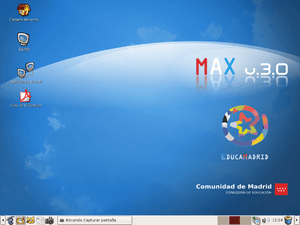MAX Linux facts for kids
MaX: Madrid_Linux is a special computer program, like Windows or macOS, but it's made for schools! The Ministry of Education in Madrid, Spain, created it. It's designed to be easy to use and very stable. It also comes with lots of helpful programs for learning.
The current version of MaX (MaX 9.5) is built on a system called Ubuntu. It's perfect for students and teachers in schools. But anyone can use it on their home computer too! MaX comes ready to go with many programs for music, videos, and more. It offers three different looks for your computer screen: GNOME, KDE, and Xfce. You can even try MaX without installing it. Just run it directly from a DVD, which is called "live" mode!
Its main goals are:
- To encourage the use of free and open-source software in schools.
- To give schools and everyone in education tools to join the digital world.
- To provide great learning apps for students and teachers without extra cost.
- To create an open environment for learning and exploring new ideas.
Getting Started with MaX: Installation and Users
The MaX program comes on a DVD. You can use this DVD to try MaX "live" before you install it. This means you can run the system directly from the DVD drive. You can even install more programs if your computer is connected to the internet. This lets you test out apps that aren't already on the live system.
Installing MaX on your computer is quite simple. It's even easier than installing other systems like Ubuntu. You just need to create a username. MaX always comes with two built-in users: student and Madrid. The student user is for students, of course. It has fewer special permissions on the computer. The Madrid user has more permissions, but it's not the main administrator.
When you log in as Madrid, you'll use "cmadrid" (that's 'c' plus 'madrid') as the password. You can change these passwords later if you want. You can also create new users and choose what they are allowed to do. Many people just stick with the Madrid user. When you need to do something as an administrator, you just type "cmadrid" as the password.
Your MaX Computer Screen: The Desktop
The main MaX computer screen, called the desktop, usually has a bright blue background. It often shows a round image that looks like Earth. This is the GNOME desktop, which MaX uses as its main look.
But you can also choose to use two other desktop styles: KDE and Xfce. To switch, you just log out (don't restart your computer). Then, when you log back in, you pick a different desktop from the "Session menu." It only takes a few seconds! No matter which desktop you choose, the background and the bar at the bottom of the screen usually stay the same. The programs are also mostly the same across all three desktops. Some small things might change depending on the desktop you pick.
Awesome Programs in MaX
MaX Linux comes packed with many useful programs. They are organized into different categories to help you find what you need. Here are some of the types of programs you'll find:
| PROGRAMS | Geography | Childish and Primary Education | Programming |
| Audio | GPS | Internet | Networks |
| Virtual Classroom | Graphics | Games | Robotics |
| Sciences | Author's Tools | Language | Systems |
| Web Design and Publishing | Languages | Mathematics | Streaming |
| Electronics | Image-Photography | Music | Video |
| Business | 3D Printing | Digital Whiteboards | Selections |


